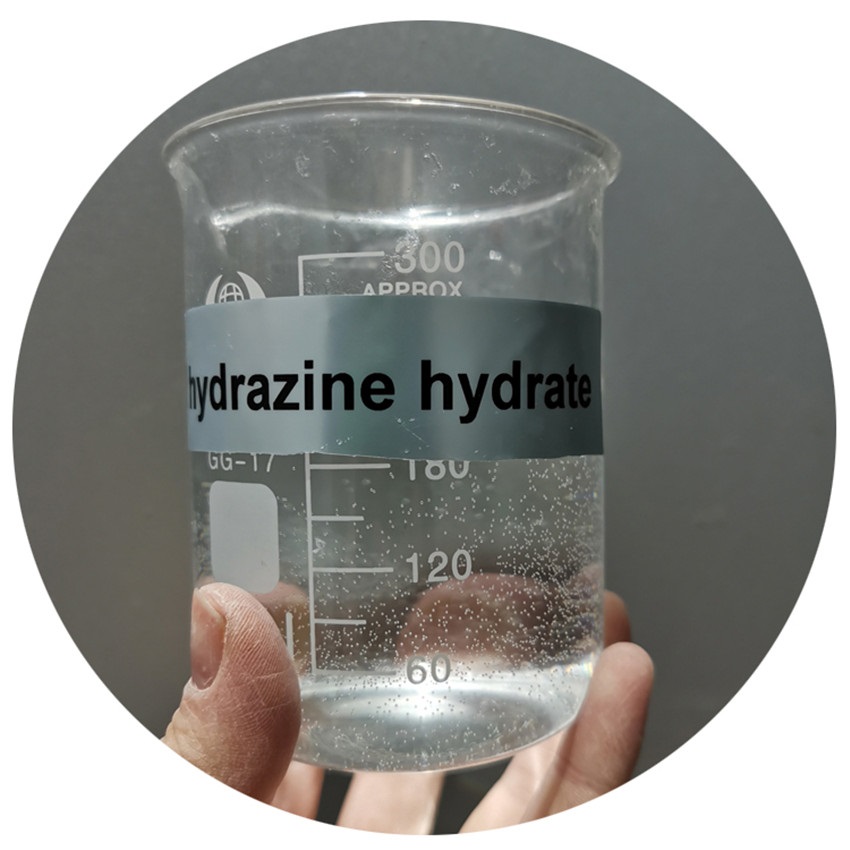We unleash your business potential by maximize the business innovation.
Send EmailHydrazine Hydrate, Hydrazine Monohydrate, Diamide Monohydrate, Hydrazinium Hydroxide, 10217-52-4, 7803-57-8
hydrazine hydrate
CAS: 10217-52-4;7803-57-8
Molecular Formula: H6N2O
Names and Identifiers
| Name | hydrazine hydrate |
| Synonyms | hydrazine hydrate Diamide monohydrate Hydrazinium hydroxide Hydrazine monohydrate Hydrazinium hydroxide solution |
| CAS | 10217-52-4 7803-57-8 |
| EINECS | 206-114-9 |
| InChI | InChI=1/H4N2.H2O/c1-2;/h1-2H2;1H2/p-1 |
Physico-chemical Properties
| Molecular Formula | H6N2O |
| Molar Mass | 50.053 |
| Density | 1.03 g/mL at 20 °C |
| Melting Point | -57℃ |
| Boling Point | 120.1 °C(lit.) |
| Flash Point | 204 °F |
| Water Solubility | miscible |
| Vapor Presure | 5 mm Hg ( 25 °C) |
| Refractive Index | n20/D 1.428(lit.) |
| Physical and Chemical Properties |
density 1.032 |
| Use | Used as reducing agent and solvent |
Risk and Safety
| Hazard Symbols | T - Toxic N - Dangerous for the environment  |
| Risk Codes | R23/24/25 - Toxic by inhalation, in contact with skin and if swallowed. R34 - Causes burns R43 - May cause sensitization by skin contact R45 - May cause cancer R50/53 - Very toxic to aquatic organisms, may cause long-term adverse effects in the aquatic environment. |
| Safety Description | S45 - In case of accident or if you feel unwell, seek medical advice immediately (show the label whenever possible.) S53 - Avoid exposure - obtain special instructions before use. S60 - This material and its container must be disposed of as hazardous waste. S61 - Avoid release to the environment. Refer to special instructions / safety data sheets. |
| UN IDs | UN 2030 |
Upstream Downstream Industry
| Raw Materials | Sodium hypochlorite Chlorine Urea Sodium hydroxide |
| Downstream Products | Sodium azide 1,2,4-1H-Triazole 3,6-Dihydroxypyridazine hydrazine hydrate 1-Hydroxybenzotriazole 2-Mercapto-5-methyl-1,3,4-thiadiazole 3,6-Dichloropyridazine Benzophenone hydrazone tert-Butylhydrazine hydrochloride |
Nature
hydrazine hydrate is a colorless, transparent, oily liquid with a light ammonia odor. Generally, aqueous solutions of hydrazine hydrate or salts of hydrazine with a content of 40% to 80% are used industrially. Relative density 1. 03 (21 °c); Melting point -40 °c; Boiling point 118.5 °c. The surface tension (25 °c) was 4284 mN/m, the refractive index was 1.242, the heat of formation was -1, 72.8kg J/mol, and the flash point (Open Cup) was °c. Hydrazine hydrate is strongly alkaline and hygroscopic. Hydrazine hydrate liquid exists in the form of dimer, miscible with water and ethanol, insoluble in ether and chloroform; It can attack glass, rubber, leather, Cork, etc., and decompose into Nz, NH3 and Hz; Hydrazine hydrate reduction is very strong, with halogen, HN03, KMn04 and other intense reaction, in the air can absorb CO2, produce smoke.
Preparation Method
sodium hypochlorite and sodium hydroxide are mixed into a solution according to a certain proportion, and a mixture of urea and a small amount of potassium permanganate is added while stirring, and the oxidation reaction is carried out by directly heating the steam to 103~104 ℃. The reaction solution was distilled, fractionated and concentrated in vacuo to obtain 40% hydrazine, which was then dehydrated by caustic soda and distilled under reduced pressure to obtain 80% hydrazine. Or ammonia and sodium hypochlorite as raw materials. 0.1% bone glue was added to ammonia water to inhibit the transitional decomposition of hydrazine. Sodium hypochlorite was added to ammonia, under strong stirring under normal pressure or high pressure oxidation reaction, Mr. chloramine, continue to react to produce hydrazine. The reaction solution was distilled to recover ammonia, and then sodium chloride and sodium hydroxide were removed by positive control distillation. The evaporation gas was condensed into low concentration hydrazine, and then different concentrations of hydrazine hydrate were prepared by fractionation.
Use
It can be used as a gel breaker for oil well fracturing fluid. As an important fine chemical raw material, hydrazine hydrate is mainly used to synthesize foaming agents such as AC and TSH, and also used as a cleaning agent for deoxygenation and carbon dioxide removal in boilers and reactors; in the pharmaceutical industry for the production of anti-tuberculosis, anti-diabetic drugs; In the pesticide industry for the production of herbicides, plant growth modulator and bactericidal, insecticidal, rodenticide; in addition, it can also be used to produce rocket fuel, diazo fuel, rubber additives, etc. In recent years, the application field of hydrazine hydrate is still expanding.
Safety
is highly toxic, strongly eroding the skin and blocking the body's enzymes. Acute poisoning, can damage the central nervous system, most cases can be fatal. In the body mainly affects the function of carbohydrate and fat metabolism. With hemolytic properties. Its vapor can erode the mucosa, and lead to dizziness; Eye irritation, eye swelling, suppuration. Damage to the liver, lowering blood sugar, lack of blood, and cause anemia. The maximum allowable concentration of hydrazine in air is 0.1 mg/m3. Staff should be fully protected, skin and eyes after contact with hydrazine, should be directly rinsed with plenty of water, and ask the doctor for examination and treatment. The work area must be adequately ventilated and the hydrazine concentration in the environment of the production area must be detected frequently using appropriate instrumentation. Should be stored in a cool, ventilated, dry warehouse, storage temperature below 40 ℃, and to prevent sunlight. Keep away from fire source and oxidant. Fire, can use water, carbon dioxide, foam, dry powder, sand, etc.
Nature
| melting point | -51.7°C (lit.) |
| boiling point | 120.1°C (lit.) |
| density | 1.073 g/mL at 25 °C |
| refractive index | n20/D 1.428(lit.) |
| flash point | 73 °C |
Security information
| dangerous goods mark | T,N |
| hazard category code | 45-10-23/24/25-34-43-50/53 |
| safety instructions | 53-45-60-61 |
| dangerous goods transport number | UN 2030 8/PG 2 |
| WGK Germany | 3 |


